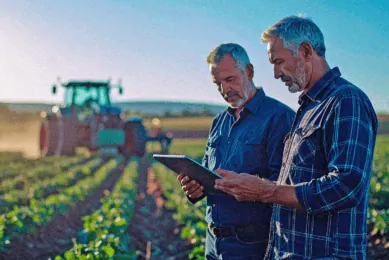Smarter machines at Belgian potato trade fair Interpom

The Belgian trade fair Interpom in Kortrijk is traditionally known for enjoying a beer, eating fries with mayonnaise, and viewing the latest innovations in potato-related machinery. Developments these days are primarily focused on AI and electronics.
The indoor trade fair Interpom is a biennial event held in Kortrijk, Belgium, that caters to the entire potato supply chain, from cultivation to processing to marketing. Interpom took place from November 24 to 26 at the Kortrijk Xpo exhibition halls. The fair is a key meeting point for farmers, contractors, potato processors, potato traders, machine manufacturers, and packagers from across Europe.
The first edition of Interpom was held in 2001, initially as a small networking event for the fruit and vegetable sector. From 2010 onwards, potato cultivation machinery began to take on a more prominent role at the event. For the past decade, manufacturers of potato mechanization equipment have been showcasing their innovations at Agritechnica during odd-numbered years and at Interpom during even-numbered years.
Baselier introduces Isobus-planting-tiller combination
The planting-tiller combination from Dutch manufacturer Baselier has been on the market for twelve years. The latest model now offers optional Isobus control, allowing users to adjust settings like variable planting distance, planting depth, and pressure on the ridging discs via the monitor. Isobus control is deliberately not standard but optional, as many regions have little demand for this feature.
The model displayed at the trade fair was an XL version, featuring larger wheels, a larger tiller with a width of 75 cm instead of 60 cm, and 128 tiller blades instead of 100. The planting combination weighs 4.2 tons when empty. To lift the machine with a full bunker, a tractor with at least 250 hp is required. The Isobus option adds €30,000 to the price. The base model starts at €71,000, while the XL version with Isobus costs just over €100,000.
Text continues below picture

Croptic spot spraying and Y-Virus detection
Belgian start-up Croptic enables farmers to use their conventional field sprayers as spot-sprayers. This is achieved through weed maps generated with drones and AI. For potatoes, this technique is ideal for targeting problem weeds that survive general treatments, such as yellow nutsedge, thorn apple, chickweed, thistle, and volunteer potatoes in subsequent crops.
The task maps are compatible with nearly all brands of GPS terminals. Croptic employs two innovative technologies: DGR and Rapid AI Prototyping.
- DGR: Their image processing system collects drone images with only 10% overlap, compared to the traditional 75% or more. This reduces data requirements by 90% and allows the creation of high-resolution images using relatively inexpensive drones.
- Y-Virus Detection: Croptic’s second innovation can identify and differentiate Y-virus-infected plants from healthy ones. This data can be used to mark infected plants with dye, enabling their removal by unskilled workers.
The company aims to have this system ready for practical use by early 2026, beginning with lower-grade seed potato classes.
Text continues below picture

Verdusense Soiltech Sensor
The Belgian company Verdusense has become a distributor for the Soiltech sensor from Idaho, often referred to as an ‘electronic potato’. This sensor measures conditions throughout the entire process – from cultivation to storage. Planted simultaneously with the potatoes, it tracks parameters such as soil temperature and moisture, and then wirelessly transmits the data to a computer or smartphone.
After harvest, the sensor can be placed among the potatoes in storage, where it continues to measure the same data, including CO2 levels. The sensor is shock-resistant and can survive a trip through the harvester. However, it’s generally advisable to dig it up before harvesting to ensure its longevity. The sensor costs €500, with an annual subscription fee of €100.

Join 17,000+ subscribers
Subscribe to our newsletter to stay updated about all the need-to-know content in the agricultural sector, two times a week.



